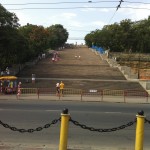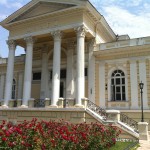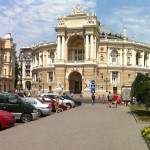
Today we were in Odessa, Ukraine, a port city on the northeastern coast of the Black Sea. It’s a major city with a population of more than 1,000,000. Movie buffs know Odessa as the site of the famous Communist Era (1925) movie, Battleship Potemkin, and the Potemkin Steps where the massacre in the film takes place.
The actual massacre, a government response to the stirrings of revolution in the city, did not occur on the steps but down the street in the city. The uprising was aided by a Russian battleship (the Potemkin) that had been commandeered by its mutinous crew, unhappy with what was being served for dinner.

At the top of the Potemkin Steps, we got a look at the beautiful pre-Communist architecture that defines Odessa. My experience here is obviously limited, and I only saw part of the city, but it reminded me of what I had seen a few years before in St. Petersburg, Russia.
The beauty of St. Petersburg was found in pre-Communist design and architecture. The uninspiring, plain, purely functional buildings were by-and-large built during the Communist era, while the beautiful, ornate structures, pre-date it. I’m sure there are exceptions, but this seemed, at least based on what I saw there and here in Odessa, to be the general rule.

I guess this shouldn’t be surprising. I can’t think of a single atheist renaissance in history. I can think of a number of Christian renaissances. The 9th century Carolingian Renaissance (Charlemagne), the 12th century Byzantine Renaissance and the 13th century French Renaissance (Saint Louis) all come to mind. In fact, many believe the Italian Renaissance was the result of the influx of the Byzantines into Italy after the fall of Constantinople in 1453.
Perhaps the moral to this story is that the glorification of fallen man is an inferior inspiration for creative genius. GS

